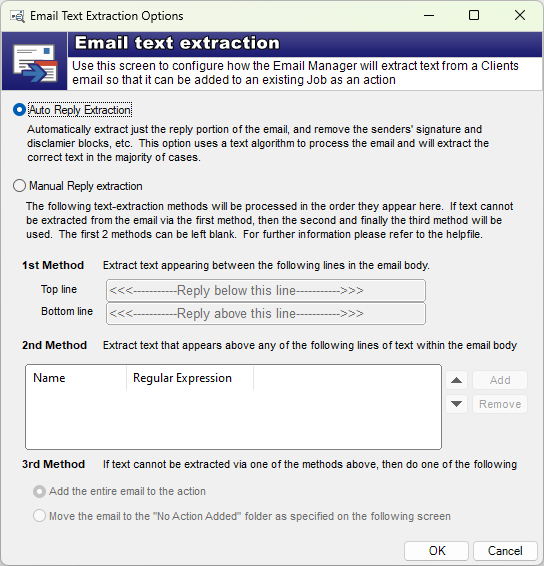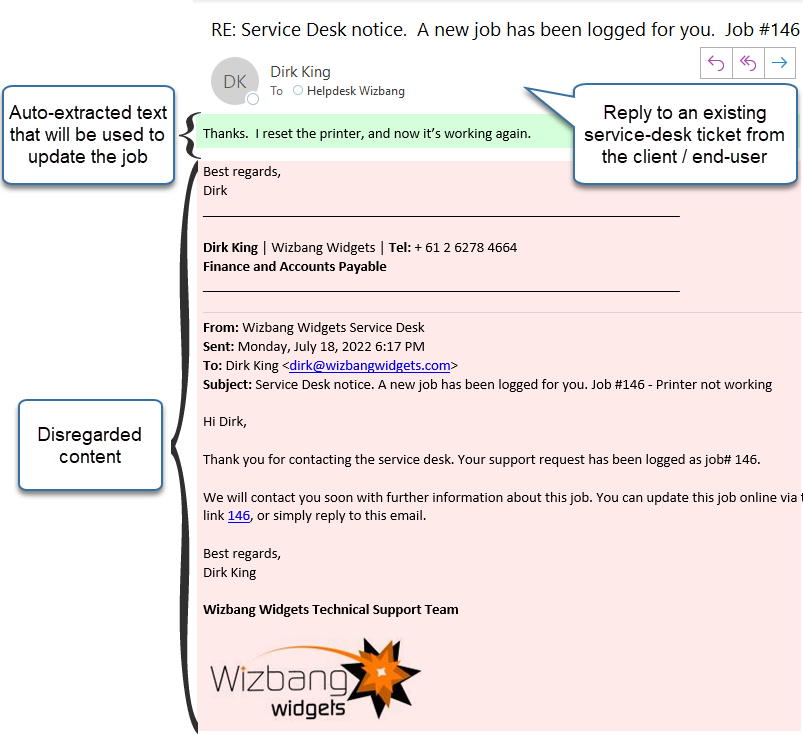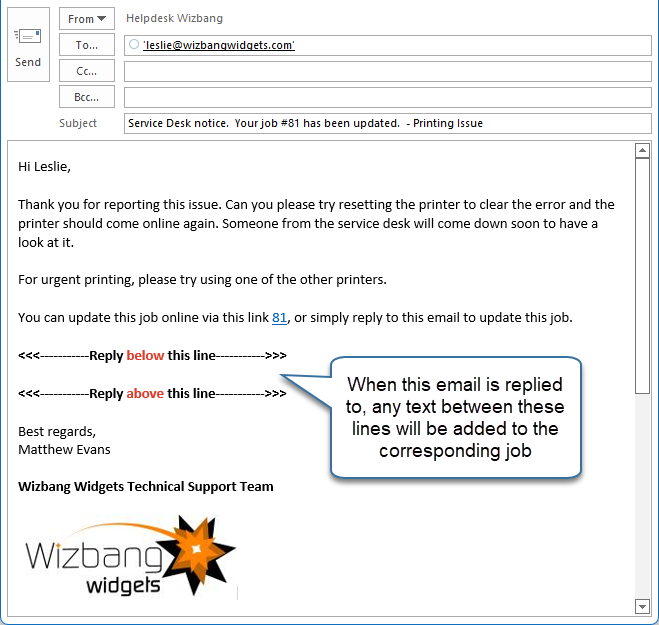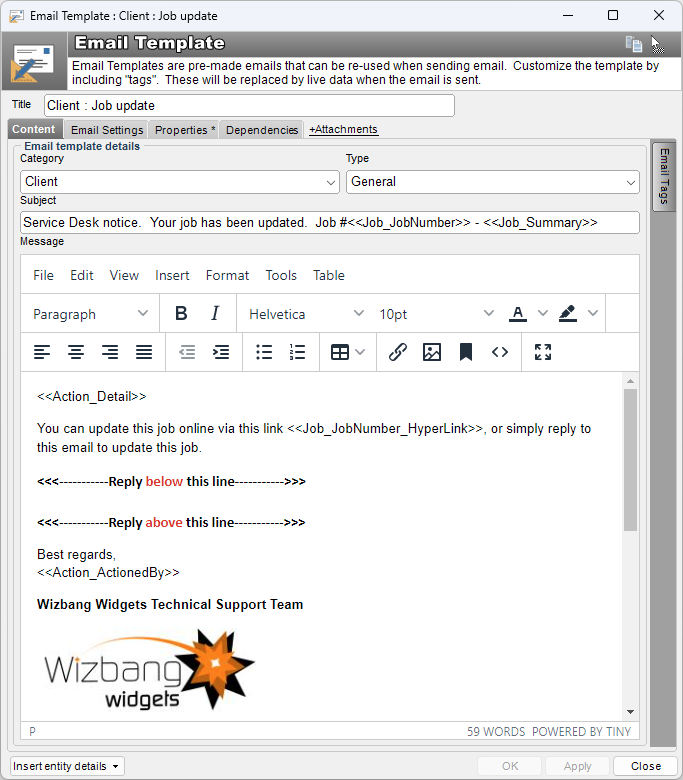Email text extraction
Email Text extraction refers to the process of extracting only the most recent “reply” portion of an incoming email and using that to update the job, rather than simply adding the entire email to an existing job which may contain the whole email history (which would quickly bloat the job history, and make it harder for staff to understand the context of the job).
Text extraction only applies when the Email Manager profile is set as “Update Job” in the processing options.
The text extraction configuration determines which part of the incoming email to use. In many cases, it is desirable to only update the job with just the reply text of the incoming email - rather than the whole thread of the email. Email messages can quickly become quite long and contain redundant (and repetitive) information after several exchanges between sender and receiver. In many email configurations, this is a natural occurrence when an email is continually “replied” to. In a helpdesk/support context, you usually only want to include the most recent comment from the client/customer email to update the job with.
When the Email Manger processes an email that is an update to an existing job, it updates the job via an Action Template.
The Email text extraction screen allows you to instruct the Email Manager to only focus on a certain section of the email body, and discard the rest. The text that is extracted is then inserted into the Action Template that is selected for use with the Email Manager profile being processed at the time.
Text extraction and its effect on filters - Important!
Note! The message filters for each Email Manager profile are affected by the text-extraction options set here. When the filtering logic is processed for the “Message” part of the email, the Text Extraction options set here will be evaluated first, and then the filters will be evaluated. This allows you to configure filters that only relate to the extracted text from the email. Use the “Test” button on the filters to verify the filtering behaviour.
Auto Reply Extraction
The auto reply extraction method is the default and recommended option.
Note! This option only works on “Update” profiles.

This option uses an algorithm to automatically extract just the reply part of the incoming email. The algorithm will also attempt to filter-out email signatures, and graphics associated with signatures.
Please note that this option, and the algorithm used does not offer 100% accuracy in the way that it extracts text, and has been developed to work with the English-language only. Even when processing English replies, a small minority of email may be parsed and processed incorrectly. Remember though, that HelpMaster will always store the original email text, so you can always view the original email text. This is achieved by clicking the “View original email” link on the Action screen.

Whenever the auto-extraction algorithm updates a job (new, or update), only the extracted portion will be displayed, however the complete, original text is still available to view by clicking the hyperlink “View excluded details”.

Manual Reply Extraction
When the Email Manager is running in Manual mode, it will attempt to extract text from an email by working through the following 3 different methods in the following order.
1st Method - “Between the lines”
This method will extract text that appears between both a top line and a bottom line within the original email. By specifying both a “Top line” and a “Bottom line” marker, the Email Manager will only includes details that fall between these 2 lines within the email. In order for this method to be effective, the original email that is being replied to must contain both the top and bottom markers. This method works best when these top and bottom line markers are integrated into even client targeted email template.
For example.

In order to achieve this type of functionality, you will need to ensure that the out-going email to clients contains both the top and bottom words within the outgoing email. The easiest way to do this is to base all out-going email on a Email template that contains these lines. See the screen shot below for an example of this.

This method is optional. If no “top” or “bottom” line markers are entered here, the Email Manager will simply try the next method. Moreover, if the email does contain these markers, but text cannot be found within these markers, the next text extraction method below will be considered.
2nd Method - All text above a certain line of text, or word
The second method for extracting text from an email relies on possibility that the email contains some identifying word, or line of text that delineates where the client reply ends, and the original email text begins. The principle behind this method is the fact that most email systems will insert some sort of line marker in the email whenever the “Reply” button is clicked. This marker marks the position where the new reply text ends, and the original email begins. By telling the Email Manger to look for these markers, and then extract only text above this point in the email, it is possible to extract the most recent “reply” details of the client’s email.
If this method is used, you can specify any number of “reply line indicators”, which are regular expressions that describe the separator text. These are administered globally so that a list of common “reply line indicators” can be stored and used for other Email Manager profiles. If more than one “reply line indicators” are used, they can be ordered using the up and down arrow buttons. The Email Manager will look for these within the email in the order specified.
The method is optional. If no reply line indicators are specified, the Email Manager will simply try the next method as listed below.
Email Line Separators can be added and/or created via the Regular Expression Library.
The final method
The final method has 2 options. These are.
- Add the entire email (the default setting)
- Do nothing and move the email to another folder
See also
Feedback
Was this page helpful?
Glad to hear it! Please tell us how we can improve.
Sorry to hear that. Please tell us how we can improve.